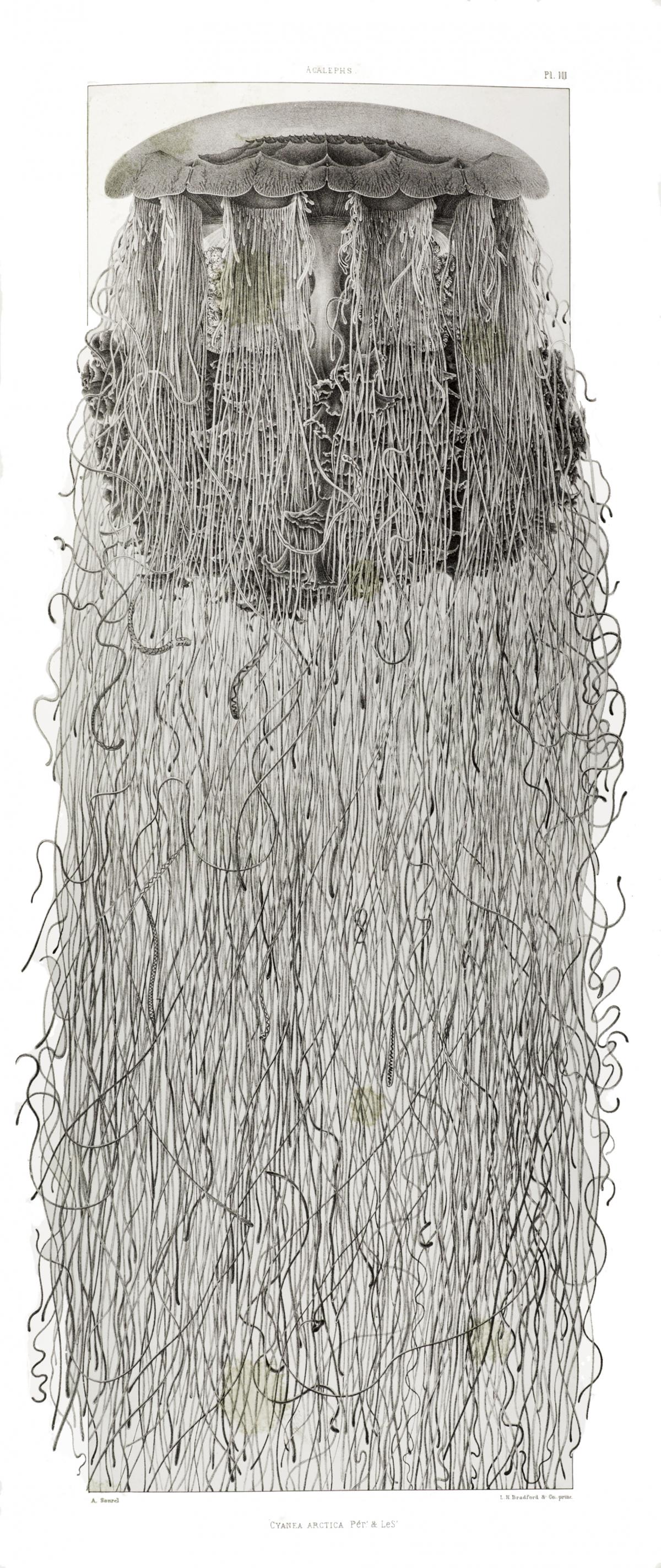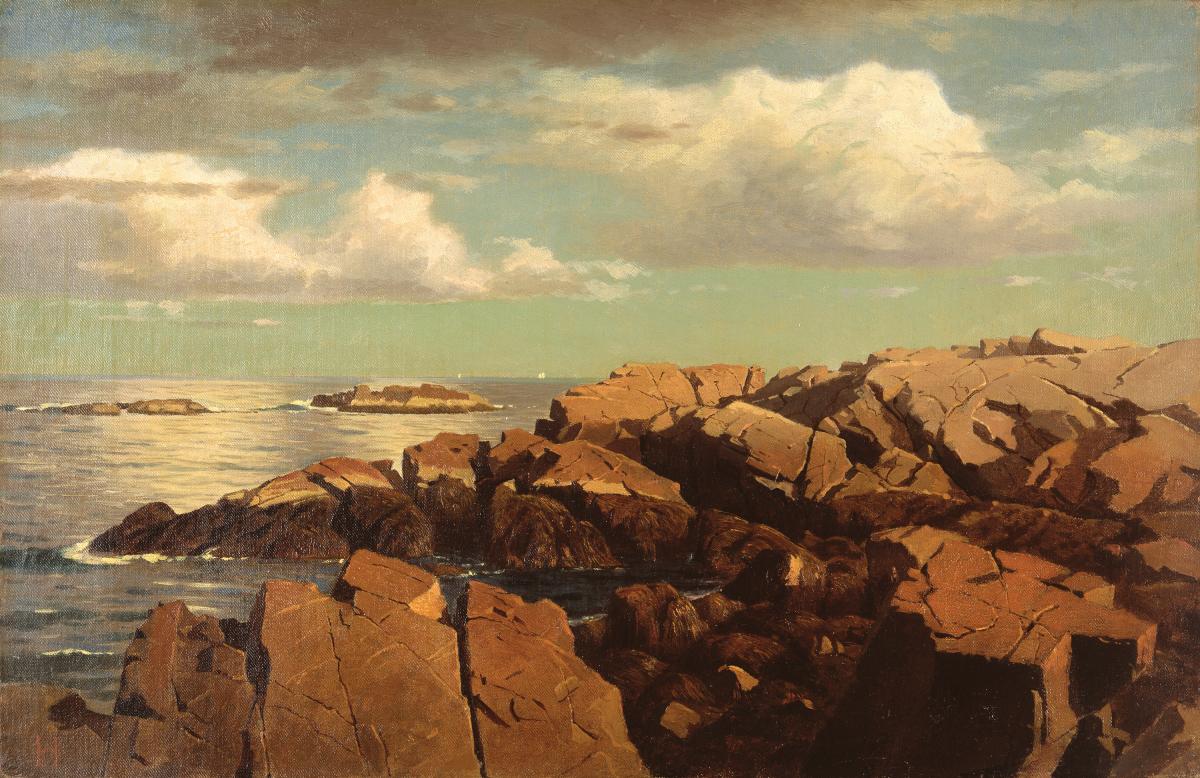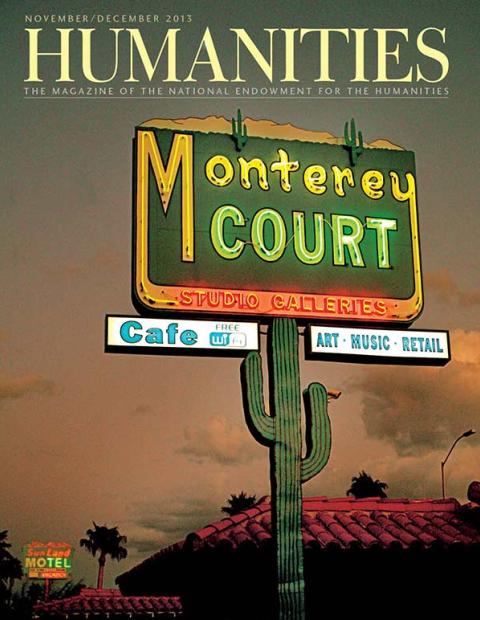Here’s how I often imagined Louis Agassiz, the subject of my recent biography: Late at night, in his laboratory on the beach at Nahant, a candle in his hand, his eyes focused on a jar, with one of his glittering, evanescent, infinitely beautiful jellyfish drifting in it. For Louis Agassiz (1807–1873), one of the founding fathers of American science, looking at nature was a serious activity. In one of his lectures, he recommended that we purge ourselves by not eating before we peer through a microscope: Having a full stomach means having a full eye, too, or at least an eye not able to hold the beauty that surrounds us.
Agassiz’ delight in America’s nature was that of a recent immigrant, of someone who does not take for granted what the books say but finds pleasure in recognizing that reality never fails to live up to, or even to surpass, his expectations. His had been a charmed life, if only from a scientific point of view. Born in the shadow of the Swiss Alps into a family of clergymen, Agassiz defied his family’s wishes that he become a country doctor and trained with the best scientists in Heidelberg, Munich, and Paris. With the likes of Carl Philipp von Martius, Georges Cuvier, and, finally, Alexander von Humboldt as mentors, he produced gorgeously illustrated scientific works, produced on his own printing press, in which glaciers traveled down mountain slopes, carrying huge boulders with them, and spectral fossil fish told tales of the world as it once was. His concept of the Ice Age (or several ice ages) liberally borrowed from ideas first suggested by others but fused them into a theory of elegance and, as far as Agassiz’ own science was concerned, compelling usefulness: Assuming that the world at one or several points in its vast history was covered by large fields of ice helped explain why some species were not around anymore.
But while so much in Agassiz’ science seemed to drift, float, and travel, he was also adamant that nature never strayed from the plan God (or the Divine Mind, as he liked to say) had mapped out in the beginning and that all species stayed within their assigned boundaries—a position that set him up for the battle of his life: against Lamarck’s ideas about transmutation and, later, Darwin’s theory of evolution. Agassiz’ mentor Alexander von Humboldt, equipped with a more Mediterranean temperament, kept reminding his intense pupil to relax. “Vos glaces me font peur,” he told him. “Your glaciers make me shudder.” Yet Agassiz was undeterred: Climbing mountaintops and lowering himself into the crevasses of glaciers, Agassiz acquired a well-deserved reputation for egotism and recklessness.
Despite rising debts, Agassiz spent increasing periods of time living in a cabin made of rocks high up in the Alps, with droves of disciples assembled around him: a modern prophet who would not come down from the mountain. For up here, in the striations and scratches on the rocks, was God’s handwriting made visible.
Not surprisingly, Agassiz’ marriage with the artistically gifted Cecilie Braun withered. The small Swiss town of Neuchâtel, where he was a professor of natural history at a preparatory school, proved too small for his oversized ambitions. In the fall of 1846, equipped with a stipend from the King of Prussia (thanks to Humboldt’s good services), Agassiz set off for the New World and never returned. From a geological perspective, “America is the Old World,” he told his mesmerized audiences in Boston, New York, and Charleston, which was exactly what they wanted to hear. It seemed that America had been waiting for Agassiz, just as Agassiz had been waiting for America. Harvard created a chair for him, and from then on Agassiz’ name regularly made the front pages of the newspapers.
For his irrepressible enthusiasm, Agassiz was loved by many of his American contemporaries: by fishermen, farmers, as well as schoolteachers, all of whom he kept reminding that science was merely a name for nurturing a keen interest in one’s environment. But no one loved Agassiz more than the poets and philosophers. Agassiz knew the meaning of poetic ecstasy. He was Emerson’s transparent eyeball personified: the divinely entitled eye or “I” (pun intended) taking in, merging with, and appropriating whatever it sees. In a famous cartoon, Emerson’s friend Christopher Pearse Cranch portrayed the Emersonian eyeball in a top hat and a suit walking on spindly legs through a New England landscape. That roaming eye could have been Agassiz, to be sure, except for the fact that Agassiz’s torso rested on strong, capable legs. It wasn’t for nothing that the poet James Russell Lowell, apprised of his friend’s death while he was vacationing in Florence, compared Agassiz to a “mountain oak” and predicted that his impact would be felt for generations. Agassiz’ closest friend, the poet Henry Wadsworth Longfellow, was less fulsome. Looking around the beach at Nahant after Agassiz’ death, the grief-stricken Longfellow saw little evidence that Agassiz, the great decipherer of nature’s secrets, had ever lived. The sea was foaming around Egg Rock as it had done for decades, if not centuries. “Why art thou silent? Why shouldst thou be dead?”
If not on the beach at Nahant, Agassiz permanently left his mark on the history of American science by making fieldwork—the art of “catching nature in the act” (or, as he would have said in his native French, prendre la nature sur le fait)—the hallmark of scientific activity.
Agassiz’ students learned their trade in the great outdoors, led by the master clutching a collapsible blackboard. Science as an abstract idea was of less interest to Agassiz than science as an activity, the profound pleasure that came from doing it. And Agassiz didscience wherever he went. Even when he went for walks around his beloved Cambridge, his pockets were stuffed with specimens. In a widely circulated story, his second wife, the brilliant Elizabeth Cabot Cary, shortly after their wedding, discovered a “good-sized” snake squirming in the boots she used for church. When she mentioned it to her new husband, he was mainly excited that it had been found again and said, “I wonder where the others are.”
Wondering where everything was became a kind of weird motto for Agassiz’ collecting activities. His acquisitive zeal knew no bounds. It is said that once, when his eyes, dim from the strain of too much watching, gave out, he used his tongue to explore a new specimen. He was unstoppable, even if this meant accumulating more material than his newly created natural history museum in Cambridge could hold: “The museum,” confessed Agassiz, “overflows from garret to cellar.” While his assistants were trying to wend their way past putrid barrels of pickled fish, sent from expeditions to remote locations all over the world, the museum never quite fulfilled the educational purpose Agassiz had set for it. But that was acceptable because Louis Agassiz was not a man to be measured even by his own standards.
Yet, there are other images of Agassiz, too, and they inevitably crowd out that lovely picture of the late-night watcher of jellyfish and the charming, if exasperating, collector of Amazonian fish. For this is what he was, too: an irascible, impatient, unpredictable professor who insisted that whatever his students did in his laboratory belonged to him; a savvy navigator of contemporary academic politics, who had Harvard presidents and Massachusetts businessmen eating out of his hand; a self-declared expert on the human races who required that slaves (first in the American South and then in Brazil) pose for demeaning photographs so that he could entertain himself and others by pointing out the alleged physical deficiencies that separated them from the white master race. Agassiz’ racist theorizing did a lot of damage, and there is little comfort to be derived from the fact that his views were embraced even by some of the abolitionists among his friends. Agassiz believed that the world was like a child’s puzzle box, a game that could be sorted out by anyone willing to look and learn. And yet Agassiz himself was a still bigger puzzle, one that even today never yields a coherent, definitive image.
Charles Darwin, his main antagonist, openly ridiculed Agassiz, even while he would continue to turn to him for advice on natural history matters. Darwin knew that he had to demolish Agassiz, whose worldwide fame and well-known contempt for any interpretation of nature that smacked of “development” (a word Agassiz, significantly, never learned to pronounce properly) seemed major obstacles to the wider acceptance of evolution in America. Fortunately, Darwin could rely on the services of the infinitely capable Asa Gray (1810–1888), a professor of botany and Agassiz’ colleague at Harvard. Agassiz was not prepared for resistance from within his own kingdom. The nimble-minded Gray had recognized Darwin’s importance early on and even contributed his own share to evolutionary thinking. After surveying the plant specimens sent to him from the U.S. North Pacific Exploring Expedition, Gray noted the surprising similarities between trees found in eastern Japan and the eastern United States, a fact that he knew could not be explained by Agassiz’ view that everything had been created separately according to some divine master plan.
Asa Gray, rail thin, short, always in a hurry, was the opposite of Agassiz in almost every respect, not only physically, but temperamentally. Today we would like to think of the struggle between the supporters and opponents of evolution as a duel between progressives and reactionaries, but this is not how things played out in the nineteenth century. Agassiz, a minister’s son who rejected organized religion and instead believed in the divinity that resides in all people (as long as they were white), was never to be found inside a church, while Gray was a devout Presbyterian who had once taught Sunday school and did not work on the Lord’s Day. Professor Gray had no problem regarding evolution as the ultimate proof of God’s power, a fact that bothered his friend Darwin, who once acidly remarked that while the perennially optimistic Gray was keen on observing the raindrops that nourish the earth, he, Darwin, was more interested in those that fall in the ocean—a wonderful way of summarizing Darwin’s view of nature in which there is little to offer comfort to muddleheaded humanity.
But when it came to pointing out Agassiz’ scientific fallacies, Gray pulled no punches. And he never relented either. There is an excellent, little-known example published in Nature during the last year of Agassiz’ life, when many thought Darwin’s battle had already been won (even Alexander Agassiz, the old man’s son, had secretly defected to the Darwinian camp). Gray, however, was not yet done with Agassiz.
His little “squib” (Gray’s own word) in Nature had no name attached to it, though the botanical theme, the dislike it displayed for Agassiz, and the copious biblical references left no doubt as to who had produced it. Gray began with an anecdote. He had learned that when speaking recently to members of the Massachusetts State Board of Agriculture, Agassiz had also talked about the trees on the slopes of the White Mountains—how they start out as large, strapping specimens and shrink and dwindle the higher one gets until only puny shrubs are left at the summit. This was, Agassiz had said, incontrovertible proof “that the weak survive as well as the strong.” Gray found this interpretation laughable. Feigning sympathy for Agassiz, he wrote: “Probably no naturalist, however eminent, can be expected to know everything, or even all simple things.” Behind the façade of generosity, crumbling before he had even finished his sentence, lurked Gray’s amazement at Agassiz’s obtuseness. “Can it be possible that Prof. Agassiz supposes (as his argument seems to require) that the dwarf trees in question grow and survive near the top of the mountains, notwithstanding they are not the fittest, rather than because they are the fittest, for the conditions?” That was a rhetorical question, of course. As Gray saw it, the argument Agassiz had intended to be against evolution was actually an argument for it, albeit “an extremely simple and elementary one.” Agassiz, an unwitting supporter of evolution? This was the ultimate irony, of course, worse than the overt sarcasm dripping from Gray’s essay.
In his closing, Gray imagined Agassiz addressing the faithless results of his own scientific work as Balak, the King of Moab in the Old Testament, once spoke to the prophet Balaam when the latter, instead of cursing Israel, kept predicting good things for its future: “What has thou done to me? I took thee to curse my enemies, and behold, thou has blessed them altogether” (Numbers 24:10).
Taking my cue from the caustic Gray, here’s how I now imagine Agassiz. Again he is with his favorite animals, the jellyfish of New England, but now he is outside, on the beach, in the ocean water, greedily reaching for them. He reflects on that experience in an exquisitely written passage from Contributions to the Natural History of the United States of America, Agassiz’ unfinished tribute to the wonders of the country’s natural history. Having waded into the water after a particularly beautiful jellyfish, Agassiz notices how the animal, which at first seemed but a “moving fleshy mass, seemingly destitute of all organization,” becomes an individual, “contracting and expanding, while it floats near the surface of the water.”
Agassiz bends over to touch it and instantly feels “the burning sensation it produces upon the naked hand.” The jellyfish has stung him. There are not too many of these moments in Agassiz’ writing but they are noteworthy—moments when the scientific specimen comes alive, moments when the human presumption to see and seize is challenged. It is easier, perhaps, to deny other beings their right to life and dignity when one keeps them at arm’s length, separated by the lens of the camera or the objective of a microscope. Thinking of Agassiz knee-deep in the ocean water, of his burning, stinging hand, remembering a line from the poet Eugene Field’s savage little Tribune Primer, I do feel tempted to say Three Cheers for the Jellyfish.






